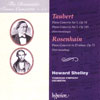Rosenhain; Taubert - Romantic Piano Concerto, Vol 51
Howard Shelley’s impressive performances make this worth hearing
View record and artist detailsRecord and Artist Details
Composer or Director: (Carl Gottfried) Wilhelm Taubert, Jacob Rosenhain
Genre:
Orchestral
Label: Hyperion
Magazine Review Date: 9/2010
Media Format: CD or Download
Media Runtime: 72
Mastering:
Stereo
DDD
Catalogue Number: CDA67765

Tracks:
| Composition | Artist Credit |
|---|---|
| Concerto for Piano and Orchestra No 1 |
(Carl Gottfried) Wilhelm Taubert, Composer
(Carl Gottfried) Wilhelm Taubert, Composer Howard Shelley, Piano Tasmanian Symphony Orchestra |
| Concerto for Piano and Orchestra No 2 |
(Carl Gottfried) Wilhelm Taubert, Composer
(Carl Gottfried) Wilhelm Taubert, Composer Howard Shelley, Piano Tasmanian Symphony Orchestra |
| Concerto for Piano and Orchestra |
Jacob Rosenhain, Composer
Howard Shelley, Piano Jacob Rosenhain, Composer Tasmanian Symphony Orchestra |
Author: Jeremy Nicholas
After Stephen Hough’s triumphant Vol 50 of Tchaikovsky, there was bound to be an anti-climax. On first hearing, I did wonder whether Wilhelm Taubert (1811-91) and his almost exact German contemporary Jacob Rosenhain (1813-94) merited their inclusion in the series. Neither has much new, unique nor, for that matter, memorable to say, though the solid craftsmanship of all three works is never in doubt. On second hearing, the Shelley alchemy began to work its magic. How he manages to play these newly learnt scores with such conviction and apparent ease while conducting from the keyboard with such precision and sensitivity is one of the musical marvels of the age.
Still, the first two movements of Taubert’s early (1833) Mendelssohnian First Concerto are not great music (the Allegro vivace’s first subject conjures up a camp male corps de ballet) though the finale is a jolly romp that puts one in mind of a Gilbert and Sullivan patter song without words. The genial Second Concerto (c1874) remains oblivious to concertos that had appeared in the intervening years (eg Liszt, Brahms and Rubinstein), its cyclic form and adroit use of harmonic juxtapositions (usefully annotated in the booklet) no substitute for unforgettable thematic material. Again, it is the catchy and vivacious finale that impresses most.
For those who delight in sparkling virtuoso display, the two outer movements of Rosenhain’s concerto (probably dating from 1840) will not disappoint, but it is the slow movement that provides the most outstanding movement of the disc. The beautifully played serene Andante on its own is bewitching enough to make this disc unmissable.
Discover the world's largest classical music catalogue with Presto Music.

Gramophone Digital Club
- Digital Edition
- Digital Archive
- Reviews Database
- Full website access
From £8.75 / month
Subscribe
Gramophone Full Club
- Print Edition
- Digital Edition
- Digital Archive
- Reviews Database
- Full website access
From £11.00 / month
Subscribe
If you are a library, university or other organisation that would be interested in an institutional subscription to Gramophone please click here for further information.




